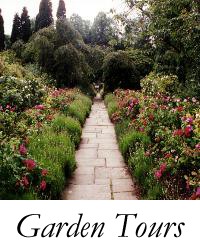

Garden Tour of the north of England, 1999
In 1999 I made another trip to England to visit gardens, and this time took lots of photos that I have used to illustrate the beauty of some particular gardens.
I also used a book called "England – Travels through an Unwrecked Landscape" by Candida Lycett Green to help plan visits to classically quiet and beautiful locations.
I flew into Edinburgh some 30 hours after leaving Melbourne and spent a few days there exploring and doing genealogical research. Then I took a rental car and headed south. The following are the highlights that I would recommend to anyone wishing to indulge in the beauty of England.
My physical capacity this time was limited by the progression of my bone marrow disease, myelofibrosis. I was able to walk for long periods as long as there were no stairs or hills and it was not hot. The heat was never a problem in England or Scotland while I was there but great distances that had to be walked from most car parks to historic houses limited my capacity to walk once I was finally there. If you are not fit then visiting England’s wonderful old houses and beautiful gardens is quite challenging.
I found two gorgeous villages, one with a thousand-year-old church (Gainford) and the other with a Roman bridge (Piercebridge). I walked all around them and took lots of photos. What a treat!
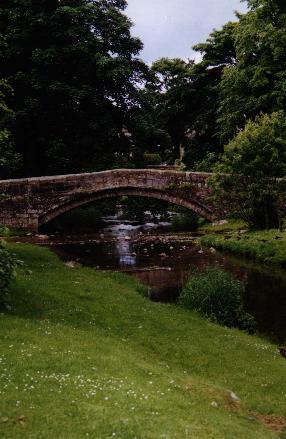
From there I drove on to York which has a beautiful cathedral where I enjoyed a Sunday morning service. It was a sung Eucharist and was very moving in that impressive environment.
On the particular day I was there a special early morning service had been held for cyclists of whom there were hundreds lined up. I was particularly amused by the high level of dog participation!
Later I went to the Treasurer’s House for a leisurely visit and lunch. The garden is charming and the place is quite different from the rather tacky style of a lot of their other tourist attractions.
As I drove across Yorkshire the countryside changed. There were more hills, lots of stone walls and fewer trees. This must be the moor at last. A saw a very dramatic rock formation and later saw it mentioned at the Bronte museum as having been featured in one of their books.
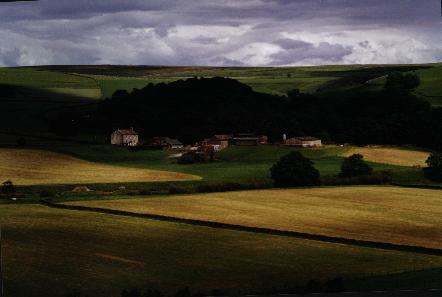
The Bronte Museum in is fabulous as long as there aren’t too many others there. Hordes of American school children and a large Japanese tour group in such a small place rather spoils one’s enjoyment, but as their visits seem to be rather short it is possible to outlast them. The churchyard had the most crowded gravestones of any I saw. The village itself is impossibly cutesy pie and over run in the tourist season so go early in the day.
From there it’s a short drive to East Riddlesden Hall at Keighley. Watch out for the right turn at a set of traffic lights not far from the roundabout. This is a charming place that is so untouched you wonder how on earth it didn’t get modernised sometime during its history. Turns out the family who had owned it for a long time moved away and left it tenanted. Then after the family died out it just remained tenanted to the estate and no improvements were made at all for over 100 years. Eventually the whole area was bought by property developers for suburban development and a local pair of brothers made the effort to arrange to have the house and gardens separated out and given to the national Trust. Most interesting.
I based myself at Ripon for a couple of days, as there are many wonderful spots to visit nearby including the beautiful market town of Helmsley.
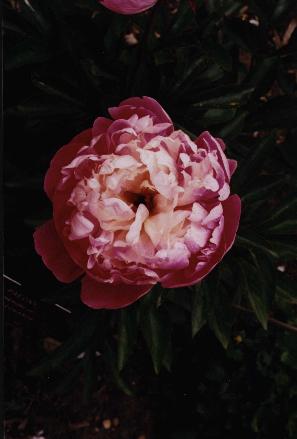
Don’t miss the Helmsley Walled Garden Restoration (not well sign posted), an interesting project in which a local woman had found a completely overgrown spot that had been the castle garden, then commercial market gardens. She persuaded the owner to let her restore it using volunteer help over five years. Sadly she had recently died of a weak heart, but the project now has enough momentum and charitable status so that it can continue. It is lovely to see work in progress and the flowers are beautiful.
From there I went to Rievaulx Abbey where I found the audio guide very helpful. It is a long walk from the car park to the Abbey through country grounds but once there it is very impressive. It had been a monastery for 400 years, of enormous size and set in a beautiful valley. Now it is all ruins but you can get a good sense of what it would have been like.
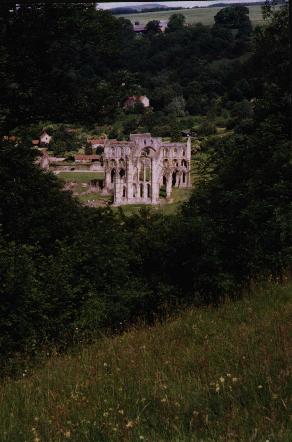
Then I drove up to the Temple and statues on a hill overlooking the abbey. This is a separate property and again a very long walk involved; over a mile. The view over the abbey is not as distinct as it once was because of the growth of the trees. A lot of walking to see not very much.
From Helmsley I drove to the White Horse site on Sutton Bank. I couldn’t manage the stairs up to it so didn’t get a clear view. It was an odd site with a lot of military activity around it including lots of big machine covered with camouflage and armed soldiers at gates with paint on their faces. On the top of the hill there was an airport with small planes and a glider in operation. I then tried to find the Druid’s Folly but without success. I heard later that the signs have been removed, as the owner doesn’t want visitors. I drove for ages in very narrow country lanes of only one lane width, which was a bit scary, but fortunately not too much other traffic. Got frightened out of my wits by an extremely loud, low flying military plane, which seemed to swoop out of nowhere and roar just above me.
Newby Hall and Gardens is another lovely spot with tapestries on the walls over 200 years old.
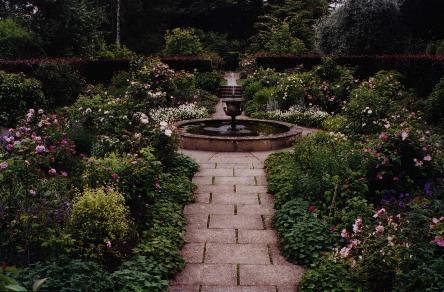
I like to be the first one in to places I really want to see so made a special effort to be there at opening time for Fountains Abbey. The first half-hour I saw barely a person. It is a very peaceful, calm and moving place but a long walk from the entrance down to the abbey, then further through the extensive water gardens. The countryside was quintessentially English, green and very lush. The water gardens were exquisitely beautiful and it was easy to meditate while sitting there. It covers a huge area and I missed the waterfall.
Unfortunately one has to do a complete circuit to get out and the last part is a long section up a very steep hill. This was my undoing but there was no alternative as there were no staff or means of transport for the return. For the fit and healthy only despite the attraction of the stunning beauty.
Castle Howard is a reasonable drive away as long as the roads are open. I had great difficulty in managing the English system of a blunt sign saying road closed, with no alternative instructions as to how to get around the closure.
The Castle was quite overwhelming, filled with ornate treasures. They had a lovely display of the making of Brideshead Revisited TV series. I wandered through the garden in light rain but just did the rose section closest to the house. That is very beautiful. At the entrance they have a glass blowing studio which was interesting.
From there I drove on to Whitby on the coast where I had the usual English town problem of poor signage to the tourist office, no parking near it, congested streets, difficulty in turning when you want to because of one way streets so I went round and round the town for quite a while before I finally made it to the tourist office. There they had difficulty in finding a place with parking that would accept a single so I ended up twenty minutes drive out of town in Runswick Bay, a fishing village population 40. At usual times this is probably quite charming but at present the whole beach area is being dug up so there is no access at all to the beach and fishing village, a lot of noise and smell from the major construction works going on. It didn’t really bother me because it was just a place to sleep.
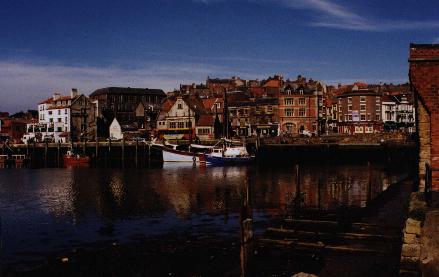
Whitby is a place for walking and the morning before the crowds arrive is definitely best.
The Captain Cook museum where he lived while training is most interesting and has a very knowledgeable historian on location. My contribution to the town’s economy was in the form of a pair of antique carved jet earrings. I bought a picnic lunch and went up to the Abbey, which has a wonderful view out to sea, over the harbour and town.
Ormesby Hall, Middleborough is an interesting old house, nearly ruined in the 1700s when the owner went bankrupt and sold everything in the house. The National Trust had to acquire the furniture later. The house was built in separate pieces and later joined with a middle section. There are a lot of holly trees in the garden.
By now it was time to head north, trying to avoid cities and towns. Cambo near boasts
Wallington, a house with a lot of dolls houses. But its real attraction is the beautiful walled garden, conservatory and lake, another long walk from the car park. There had been a major flood through it within the last five years but the recovery was terrific.
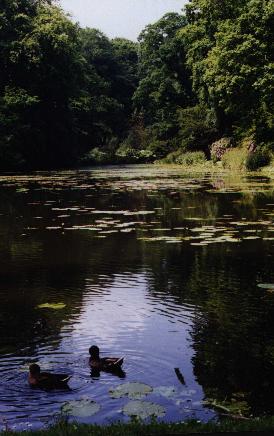
The next stop was Cragside House, which had the first hydroelectric scheme. It was a huge house filled with incredible stuff set in a very hilly and wild terrain. You can drive through the garden here which is good enough.
I went to Lindisfarne but couldn’t manage the distance between the car park and the abbey so drove on again to the beautiful area around Wooler and Chatton.
From there you must visit the wonderful Chillingham Castle. Now here I must confess a biased interest, as this is where my ancestors lived for several hundred years in their path from Normandy to Scotland. The English Greys who stayed on here included the Earl Grey of the tea fame. The Scots use the spelling Gray.

While I was there, quite by chance, I met the current owner of the castle who has been working on its renovation for fifteen years and I spent an enjoyable afternoon with him looking all over the fascinating property.
On to Scotland, I’ll mention the properties I visited which are associated with the Gray family history based around the Dundee area.
First stop was Huntingtower Castle, north of Perth. This was the seat of the Ruthven family. Barbara, daughter of William second Lord Ruthven married Patrick, 5th Lord Gray. Her brother, Patrick, the 3rd Lord Ruthven was involved with the murder of Rizzio at Holyrood Palace in 1566. The castle is small, with little in it apart from bats.
Our second stop was Kinfauns, which has been turned into an up market hotel. Kinfauns was built in 1822 by the Gray family and sold in 1926.
We went to the Gray House that showed some progress since last year but still has a long way to go before completion. Gray House was built 1714 – 16. The beautiful old trees are still in good condition.
The next stop was the Benvie Mill and graveyard. This time the ivy growing over the church ruins has been cut back so the church can clearly be seen.
From there, on to Dundee and a brief visit to Broughty Castle, built by Andrew, 2nd Lord gray in 1496 and sold in 1666.
Easter Fowlis and the church were next and it was interesting to see that the whole village is being redeveloped for upmarket townhouses. Although there has been a church on the site since 1150, the current church was built by Sir Andrew Gray, first Lord Gray about 1453. Patrick, the 4th Lord Gray was involved with the paintings done about 1541.
We looked at Fowlis Castle from a nearby lane. It is only part of the original castle and has unsympathetic additions (now is in apartments). It is thought to have been the first significant house the Grays had in this area. The first Lord married Janet de Mortimer and inherited the castle, built before 1178, through her.
Castle Huntly was the main Gray family accommodation from and is now a prison for young men and can’t be visited.
One last place I want to mention is Culzean Castle, which was on a most impressive site on a cliff top on the west coast of Scotland. The day we went was a sparking one and we could easily see all the Scottish islands and even Ireland. The road to get there from Edinburgh is awful, narrow and rough with no passing facilities. You need to allow twice as much time as you would think to get there.
Garden Tour of the south of England, 1998
In June 1998 I flew to London for a garden tour of the southern half of England. Unfortunately my 900 photos were in my luggage which was stolen off a train when it stopped for two minutes at an East German station in transit from Berlin to Sweden. Therefore the visuals are few. Perhaps one day I will be able to return and take even better photos. These were some of the highlights.
The first garden, and one of the best was Groombridge in Kent. This is an enchanting garden. The day I visited was the usual English summer day: grey, cold and rainy. I was the only person there until near the end of my visit. I was able to imagine that it was mine as I wandered around. There is nothing tacky or commercial about it and lots of imagination used.
There is a formal garden with topiary, a chess set (where the film “The Draughtsman’s Contract“ was filmed, 300 year old apple and yew trees (one with mistletoe from Queen Victoria’s day growing in it); wonderful herbaceous borders in blue and yellow; peacocks strolling around; birds of prey; a boat along a small canal; a shipment of Australian tree ferns recently planted in the valley (brought from Victoria following road clearing and shipped in cool containers at a cost of 25,000 pounds). Sir Arthur Conan Doyle used to visit frequently and set on of his Sherlock Homes stories “The Valley of Fear” here. A studio has memorabilia of his. Altogether enchanting.
Drove on to Scotney but it was closed so went on to Great Dixter. I arrived at 2.10 pm for a 2 pm opening and it was already crowded including a bus from Holland. Long queue to go into the house which was built in the 1400s and is still lived in. All very English, run down charm and rustic. Not mad about the garden but interesting to see.
Drove on to Bodiam Castle; not much of it left apart from the shell. It looks like a classic children’s sand castle and is quite stunning to see from a distance. You are just driving along and suddenly there is a castle.
Drove on to Sissinghurst Castle Farm, just in time for thirty minutes in the dusk and rain in the garden. Exquisite. Stayed for two nights in the B& B at the farm, way up on the second floor attic bedroom. Huge greasy breakfast at 8 am of fried egg, bacon, sausage, mushrooms, fried bread, tomato; cereal and fruit, toast with rhubarb and ginger jam from the farm. Other guests from all over the world, Japanese couple, German female walker, British elderly women, Australian and American couples. Very brisk English couple who run it have lived there all their lives.
Drove to Leeds Castle. I was the second car in so got the grounds to myself at first. Great aviary. Maze, greenhouses. The castle is set on a lake and dates from the 1400s with lots added and changed over the years. In the 1920s it was bought by a 26 year old woman using money inherited from her American mother who died at 40. Her sister spent her money on horses; she did the castle. It has been lived in and used since then with a rich social and political life. It was mainly decorated in the 30s but some really old and valuable stuff was around eg in the chapel. It was great. A lovely day warm, sunny, windy (most unusual).
Stopped at Headcorn Village for lunch in a cafe that I had to stoop in. A beautiful village where I took lots of photos especially around the St Nicholas church which is very old. There was the remnant of an oak tree from 1100 which is reputed to have seen King John watch bull baiting there. Picked up two fragments of the tree.
Spent the rest of the day at Sissinghurst. It was lovely to see it in both rain and sun. Lots of tourists there. Had another cream tea, this time with cherry jam and sultana scones. Took the garden at a leisurely pace and took lots of photos. Nigel Nicholson was in his retreat at the bottom of the garden reading.
The property is National Trust so my card got me in, otherwise it would have been 6 pounds each time.
Some roses were already finished but most were at their peak. The plants are very well established and it was odd to see some drooping in the heat even though it had rained the day before. Gardeners continue working while the tourists are there. Most of the irises were finished. In the library the books were all review copies sent for review so they have no covers. There are hand written labels on the shelves. Religion was up very high. Gardens have not lost their magic; still in my top three.
Thursday 25th June
A long day of driving, seven hours, but not intentional. Left Sissinghurst early and headed out on the M25 freeway. Missed a turn off and ended up heading towards London. Quite confused about where I was and after checking the may decided to follow the South West route to get out. This was a big mistake as it was not a freeway, just ordinary streets. It was very crowded and slow and I got caught in the Wimbledon traffic jam which added an extra hour. Finally got to Wisley which I didn’t much care for. It’s rather clinical and intended for showing off different plants.
Drove on to Somerset to Tintinhull. It was okay but not special. Then I drove into Yeovil thinking I would find somewhere to stay there. Turned out to be a confusing and ugly town so I went on to Taunton to try to find a B & B. It was a long haul and difficult to find one. Finally after several stops and referrals on I found one out of town about 7 pm. Went to a local pub for a meal; everyone hyped up over the world cup soccer.
Friday 26th June
Went first to East Lambrook Manor, the house of Margery Fish a famous gardening writer. It was quite small but very lush and overgrown with lots of interesting small sections.
Then off to Hestercombe where it was raining and I seemed to be the only person there for most of the time. I was almost deterred by the weather but persisted and found it all a great joy. Large valley with wonderful old trees and sculptural temples etc set in it, also an old charcoal camp. A river ran through it and had been dammed to create a lake. Great vistas and walks. Then down by the house the most charming and exuberant planting. Roses and peonies in abundance in the formal gardens. Site of the regional fire service which was odd. A fabulous garden. Spent a long time there.
Then set off for Cornwall in the pouring rain all the way. Was driving along to the sound of 2001 when I came upon huge modern windmills, quite surreal. Saw Stonehenge in the distance.
Saturday 27th June
Big day on the road through Cornwall, raining most of the time. Roads are narrow and windy and it took 1.5 hours to get to the first garden, the Lost Gardens of Heligan. Felt tired and out of sorts and didn’t enjoy it much, getting lost several times along the way through poor signage. Two hours of walking.
Went on to the fishing village of Mevagissey, a charming place having a food festival of some sort and packed with tourists. The streets were incredibly narrow and cars and people had to compete for space. Then on to Trelissick. This was a National Trust place with a ferry across the bottom. More like a botanical garden than a domestic one.
The weather finally cleared and I went on to Trebah which was the site of the D Day embarkation - quite moving. Lots of hydrangeas, pongas, palms and cabbage trees. So odd to see New Zealand trees being treated as exotic.
Common theme for all three was a valley running down to the sea, with unusually mild weather conditions and rich soil allows for species not found elsewhere in the UK. Huge wealth has been invested in the infrastructure; paths, walls, structures and planning.
Sunday 28th June
Speedo now at 825 miles. Wet and very cold day so just drove through some places I had planned to walk around in. Looked at St Michael’s Mount and the rough sea out to it and passed on. Drove through Penzance and Mousehole as they were crowded with tourists and no parking. Drove down long narrow country lanes with high hedges so you couldn’t see the sea at all. Finally arrived at Land’s End - yuk. It cost 3 pounds just to park and looked incredibly tacky so I drove on. Stopped at a tiny village and took photos of Land’s End and Sennen Cove. Back on to the main road and diverted into St Ives. It was ghastly, full of tourists and no parking, a narrow maze of streets, hard to find way out. Supposed to be a great place for painters but not on a weekend.
Long drive back up country; the area around Launceston was very pretty. Finally got on to the M5 and around the edge of Bristol. I could see a huge bridge to Wales. Then on the M4 towards London and turned off to Bath.
Late afternoon in Bath was suddenly hot and sunny and full of tourists. Parked the car and walked around the town. Went to the art gallery and saw movable modern furniture and classic paintings. Went to the Abbey with impressive stained glass windows. There was a plaque to Governor Wilson, the first Governor of New South Wales.
Monday 29th June
Grey, cold day. Had an early breakfast and drove 2 hours to arrive at Barnsley House for opening time of 10 am. Gorgeous gardens; very intricate and full of lovely colour combinations. Also walked around the village. Driving back I saw a sign for Lacock Abbey, Village and Museum so detoured into it. Wow. It was gorgeous. Lots to look at including photographic museum (Fox Talbot) and house that descendants still live in.
Tuesday 30 June
Walked all around town of Bath including the Roman Baths. Went out to the American Museum which was excellent. Lots of quilts and the story of migration and development told through family rooms with authentic furniture. Special exhibition of Shaker items.
Wednesday 1 July
Drove to Stratford on Avon and walked around for three hours. The rain drove me indoors for a coffee then started walking back to the car to fetch it before the time expired. Nearly there, I saw an Antiques sign at the end of the street and walked back to look. Found an alley of stalls including a lovely fabric shop where I spend some time and bought 12 feet of hand crocheted lace (each rose took 6 hours to make) and Irish linen tablecloth (60 pounds). Saw a Crown Ducat Orange Tree set with cup and saucer 45 pounds and side plate 25. Went to Carltonware specialist shop and met the guy who wrote the reference book. He has been collecting for 25 years and showed me his albums. Lovely stuff in the shop but very expensive. He said it is hard to get good pieces now and the prices have shot up in the last six months. He sells t a Melbourne dealer! (Think it might be Hampton). He gives lectures and is on his way to Canada. He talked of a club with 600 members.
Then drove on to Hidcote which is billed as the precursor to Sissinghurst. Wonderful garden but full of tourists, mostly very old. The roses were just past their best. It was grey and cold but no rain.
Then I went on to Kiftsgate next door and liked it even more. It is on a steep slope with a half moon shaped pond at the bottom of the garden looking out over the valley.
Drove on to Snowshill Manor, too late for the house unfortunately as it was a rare arts and crafts and full of stuff. Saw the out house with lots of strange old stuff. A long day with a lot of walking.
Thursday 2 July
Another very long day 8 am to 8 pm. I set off for Gloucester which turned out to be an ugly city and hard to find my way around. Then off to Painswick and the Rococo Gardens built in 1720. The style is lots of large trees and small very ornate sections. Plenty of walking for not much reward.
Then on to Winchcombe and Sudeley Castle which was lovely. Both house and gardens are exquisite and I spent the whole afternoon exploring. The history is very strong from Henry 8 and Catherine of Parr. Now run by an American woman who married the titled owner.
Friday 3 July
Things starting to fray at the edges and the next few days were unrewarding.
I flew from London to Edinburgh and then on to Europe (where I was very disappointed with Monet’s garden at Giverney: overcrowded with tourists and the gardens very dry and droopy).
Favourite gardens:
Groombridge
Sissinghurst
Hestercombe
Barnsley House
[Main]
All content ©1999-2005 Sharyn Cederman
Designed by Tim Cederman-Haysom. To contact me email me at tim at cederman com